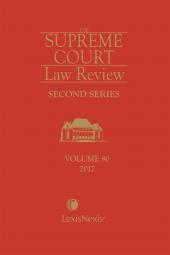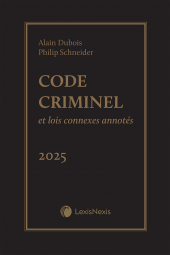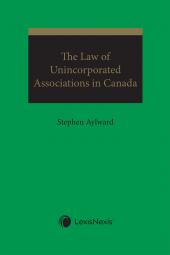The Law of Unincorporated Associations in Canada
One Year Subscription Only Terms
Subscribers receive the product(s) listed on the Order Form and any Updates made available during the annual subscription period. Shipping and handling fees are not included in the annual price.
Subscribers are advised of the number of Updates that were made to the particular publication the prior year. The number of Updates may vary due to developments in the law and other publishing issues, but subscribers may use this as a rough estimate of future shipments. Subscribers may call Customer Support at 800-833-9844 for additional information.
Subscribers may cancel this subscription by: calling Customer Support at 800-833-9844; emailing customer.support@lexisnexis.com; or returning the invoice marked 'CANCEL'.
If subscribers cancel within 30 days after the product is ordered or received and return the product at their expense, then they will receive a full credit of the price for the annual subscription.
If subscribers cancel between 31 and 60 days after the invoice date and return the product at their expense, then they will receive a 5/6th credit of the price for the annual subscription. No credit will be given for cancellations more than 60 days after the invoice date. To receive any credit, subscriber must return all product(s) shipped during the year at their expense within the applicable cancellation period listed above.
Détails des produits
Unincorporated associations include everything from political parties, sports associations and trade unions, to religious associations and social clubs. Despite the critical role that many of these organizations play in Canadian society, Stephen Aylward explains that, “[s]trictly speaking, unincorporated associations do not exist in the eyes of the law.” Unlike partnerships and corporations, unincorporated associations are not governed by any specific legislation and, as a result, this area of the law has developed primarily through the courts and the application of the law of contract, agency and trusts.
In The Law of Unincorporated Associations in Canada, Aylward takes this patchwork quilt of authorities and creates a synthesized manual that lawyers can rely on when advising clients in this space.
Indispensable and Invaluable The Law of Unincorporated Associations in Canada is the first and only book in the Canadian marketplace to offer comprehensive coverage of this area. An authoritative and consolidated reference, this text will reduce the amount of research lawyers have to do, saving time and allowing them to provide greater value to their clients.
This go-to resource addresses the many legal principles that can be applicable to unincorporated associations and examines the impact of those principles on a broad range of organizations. In addition, the sample precedents included in the book offer insight and act as an invaluable starting point for developing a constitution and membership by-laws for unincorporated associations.
In short, this portable, affordable and helpful guide will be particularly useful for corporate commercial and labour lawyers, as well as in-house counsel, as it will assist with their day-to-day practice. It would also be a useful acquisition for students at law school, college or university, and for law libraries.
Table des matières
Chapter 1: Nature and formation of the associations
I. Introduction
II. Defining unincorporated associations
III. Distinguished from other legal forms
IV. Contractual nature of the association
V. Formation
Chapter 2: Membership and governance
I. Introduction
II. Membership
III. Management of the association
IV. Multi-level associations
Chapter 3: Legal capacity
I. Introduction
II. Incapacity to sue or be sued
III. Representation order
IV. Quasi-corporate status
V. Comparative approach to legal capacity
Chapter 4: Property ownership
I. Introduction
II. Title to association property
III. The “contract-holding” theory
IV. Association property held on trust
V. Implications of the basis of property ownership
Chapter 5: Restructuring, dissolution and splinter groups
I. Introduction
II. Fundamental changes
III. Dissolution
IV. Splinter groups
Chapter 6: Contractual liability
I. Introduction
II. Capacity to contract
III. Liability of the executive committee
IV. Liability of the members
V. Indemnification
Chapter 7: Tort liability
I. Introduction
II. Direct liability to third parties
III. Vicarious liability
IV. Torts against members
V. Indemnification
VI. Not-for-profit immunity
Chapter 8: Judicial review
I. Introduction
II. Jurisdiction
III. Procedural review
IV. Substantive review
V. Remedies
VI. Domestic tribunals and arbitration
Produits liés
-
 Supreme Court Law Review, 2nd Series, Volume 80Date de sortie: November 09, 2017325,00 $
Supreme Court Law Review, 2nd Series, Volume 80Date de sortie: November 09, 2017325,00 $ -
 In Furtherance of Justice: The Judicial Life of Thomas A. CromwellDate de sortie: November 08, 2017160,00 $
In Furtherance of Justice: The Judicial Life of Thomas A. CromwellDate de sortie: November 08, 2017160,00 $ -
 Code criminel et lois connexes annotés, édition 2025 (Volume 1) + Guide du praticien (Volume 2) + Livre électroniqueDate de sortie: August 13, 2024175,00 $
Code criminel et lois connexes annotés, édition 2025 (Volume 1) + Guide du praticien (Volume 2) + Livre électroniqueDate de sortie: August 13, 2024175,00 $
 Lexis Nexis
Lexis Nexis 